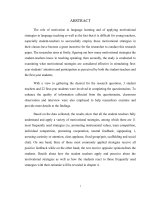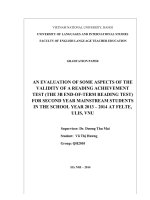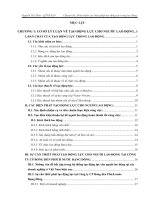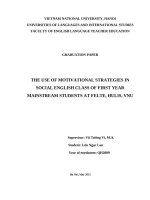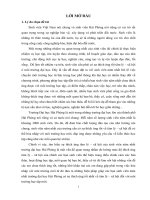VIỆC SỬ DỤNG CÁC PHƯƠNG PHÁP TẠO ĐỘNG LỰC TRONG LỚP TIẾNG ANH CHO MỤC ĐÍCH XÃ HỘI CỦA SINH VIÊN NĂM NHẤT THUỘC HỆ ĐẠI TRÀ KHOA SƯ PHẠM TIẾNG ANH, TRƯỜNG ĐẠI HỌC NGOẠI NGỮ, ĐẠI HỌC QUỐC GIA
Bạn đang xem bản rút gọn của tài liệu. Xem và tải ngay bản đầy đủ của tài liệu tại đây (886.17 KB, 103 trang )
VIETNAM NATIONAL UNIVERSITY, HANOI
UNIVERSITIES OF LANGUAGES AND INTERNATIONAL STUDIES
FACULTY OF ENGLISH LANGUAGE TEACHER EDUCATION
GRADUATION PAPER
THE USE OF MOTIVATIONAL STRATEGIES IN
SOCIAL ENGLISH CLASS OF FIRST YEAR
MAINSTREAM STUDENTS AT FELTE, HULIS, VNU
Supervisor: Vũ Tường Vi, M.A.
Student: Lưu Ngọc Lan
Year of enrolment: QH2009
Ha Noi, May 2013
ĐẠI HỌC QUỐC GIA HÀ NỘI
TRƯỜNG ĐẠI HỌC NGOẠI NGỮ
KHOA SƯ PHẠM TIẾNG ANH
KHOÁ LUẬN TỐT NGHIỆP
VIỆC SỬ DỤNG CÁC PHƯƠNG PHÁP TẠO ĐỘNG LỰC
TRONG LỚP TIẾNG ANH CHO MỤC ĐÍCH XÃ HỘI CỦA
SINH VIÊN NĂM NHẤT THUỘC HỆ ĐẠI TRÀ KHOA SƯ
PHẠM TIẾNG ANH, TRƯỜNG ĐẠI HỌC NGOẠI NGỮ, ĐẠI
HỌC QUỐC GIA HÀ NỘI
Giáo viên hướng dẫn: Th.S Vũ
Tường Vi
Sinh viên:Lưu Ngọc Lan
Khoá: QH2009
HÀ NỘI - NĂM 2013
ACCEPTANCE
I hereby state that I: Lưu Ngọc Lan, QH2009. F1. E1, being a candidate for the
degree of Bachelor of Arts ( TEFL) accept the requirements of the University relating to
the retention and use of Bachelor’s Graduation Paper deposited in the library.
In terms of these conditions, I agree that the origin of my paper deposited in the
library should be accessible for the purposes of study and research, in accordance with
the normal conditions established by the librarian for the care, loan or reproduction of
the paper.
Signature
April 14
th
2013
i
ACKNOWLEDGEMENTS
First of all, I would like to express my deep gratitude and love to my supervisor,
Ms. Vũ Tường Vi, MA for her guidance, comments, and especially her sympathy
throughout the whole research process.
I am indebted to Ms. Trần Đức Phương Anh for her helpful suggestions during
this study. I am also grateful to Ms. Phạm Thị Hạnh whose lectures and guidance have
contributed to my understanding of the research methodology and led to the completion
of this thesis.
Especially, I wish to express my appreciation to the participants including the
teachers and first- year mainstream students who spent their time helping me to collect
valuable data for the research paper.
Last but not least, I would also like to take this opportunity to send my love to my
best friends and my family who have been encouraging and supporting me whole-
heartedly.
ii
ABSTRACT
Motivational strategies are important to apply in foreign language classes as well
as the fact that new approach of teaching English in FELTE, HULIS, VNU has raised
new challenge for both teachers and first-year students have become a great drive for the
researcher to conduct this research. The study aims at investigating into the most
frequently and the most effective strategies used in social English class of first-year
mainstream students in FELTE, HULIS, VNU, as perceived by both the students and the
teachers.
In order to achieve these aims, 9 teachers and 223 students from 9 classes were
involved in completing the questionnaires. Besides, observations and interviews were
employed to triangulate the data from various aspects and hence ensure the validity as
well as reliability of the research.
Based on the data collected, Elicitation of self or peer correction, Establishing
relevance, Scaffolding, Personalization, Promoting cooperation and Inconsistent
group/pair work are considered the most frequently motivational strategies. Additionally,
according to the teachers, Team competition, Establishing relevance, Elicitation of self or
peer correction, Scaffolding, Effective praise and Personalization are the most effective
techniques. On the other hands, from the students’ perception, Elicitation of self or peer
correction, Establishing relevance, Effective praise, Inconsistent group/ pair work are the
most effective motivational strategies.
Based on these findings, implications were made for teachers and classroom
teaching. Among many, three motivational strategies, namely Elicitation of self or peer
correction, Establishing relevance and Effective praise were highly evaluated by both the
students and the teachers. As a result, these four strategies might be recommended as the
most outstanding strategies for the teachers to apply in their class.
iii
TABLE OF CONTENTS
ĐẠI HỌC QUỐC GIA HÀ NỘI i
TRƯỜNG ĐẠI HỌC NGOẠI NGỮ i
KHOA SƯ PHẠM TIẾNG ANH i
KHOÁ LUẬN TỐT NGHIỆP i
VIỆC SỬ DỤNG CÁC PHƯƠNG PHÁP TẠO ĐỘNG LỰC TRONG LỚP TIẾNG
ANH CHO MỤC ĐÍCH XÃ HỘI CỦA SINH VIÊN NĂM NHẤT THUỘC HỆ
ĐẠI TRÀ KHOA SƯ PHẠM TIẾNG ANH, TRƯỜNG ĐẠI HỌC NGOẠI NGỮ,
ĐẠI HỌC QUỐC GIA HÀ NỘI i
Giáo viên hướng dẫn: Th.S Vũ Tường Vi i
Sinh viên:Lưu Ngọc Lan ii
Khoá: QH2009 ii
HÀ NỘI - NĂM 2013 ii
ACCEPTANCE i
ACKNOWLEDGEMENTS ii
ABSTRACT iii
TABLE OF CONTENTS iv
vi
LIST OF TABLES vii
LIST OF FIGURES viii
LIST OF ABBREVIATIONS ix
PART I: INTRODUCTION 1
PART II: DEVELOPMENT 5
CHAPTER 1: LITERATURE REVIEW 5
1.Definition of terms and related terminologies 5
1.1.Motivation 5
1.1.1.Definition of motivation 5
1.1.2.Motivational theories and constructs 6
1.1.2.1.Goal orientation theory 6
iv
1.1.2.2.Self- determination theory (SDT) 6
1.1.3.Motivation in second language learning (L2) 7
1.1.4.The importance of motivation in English Language Teaching (ELT) 7
1.1.5.Motivational strategies frameworks 8
1.1.6.Framework of motivational strategies in this study 10
2.The context of teaching social English to first-year mainstream students at FELTE,
HULIS, VNU 12
2.1.The context 12
2.2.Communicative Language Teaching approach 12
3.Related studies 13
CHAPTER 2: METHODOLOGY 16
CHAPTER 3: FINDINGS AND DISCUSSION 26
1. Research question 1: What motivational strategies are most frequently used by
teachers at FELTE, HULIS, VNU in social English lessons of first-year mainstream
students, from the perception of both the students and the teachers? 26
2. Research question 2: What motivational strategies are most effective for first-year
mainstream students at FELTE, HULIS, VNU in social English lessons, from the
perception of the teachers? 29
3. Research questions 3: What motivational strategies are most effective for first-year
mainstream students at FELTE, HULIS, VNU in social English lessons, from the
perception of the students? 38
PART III: CONCLUSION 43
1. Summary of the findings 43
2. Pedagogical implications of the study 44
3. Limitations of the study 45
4. Recommendation for further research 45
REFERENCES 46
APPENDICES 50
Appendix 1. Motivational variables and their description 50
v
Appendix 2: Observation checklist 53
Appendix 8: Teacher T2’s interview transcript 67
Appendix 9: Teacher T3’s interview transcript 70
Appendix 10: Teacher T4’s interview transcript 71
Appendix 11: Teacher T5’s interview transcript 73
Appendix 12: Teacher T6’s interview transcript 74
Appendix 13: Teacher T7’s interview transcript 75
Appendix 14: Teacher T8’s interview transcript 77
Appendix 15: Teacher T9’s interview transcript 79
Appendix 16: Student S1’s interview transcript 80
Appendix 17: Student S2’s interview transcript 81
Appendix 18: Student S3’s interview transcript 82
Appendix 19: Student S4’s interview transcript 83
Appendix 20: Student S5’s interview transcript 84
Appendix 21: Student S6’s interview transcript 85
Appendix 22: Student S7’s interview transcript 86
Appendix 23: Student S8’s interview transcript 87
Appendix 24: Student S9’s interview transcript 87
vi
LIST OF TABLES
TABLE PAGE
Table 1: Observational variables measuring learner’s motivated behavior 19
Table 2: Procedures for Observation Scheme Development 19
Table 3: Procedures for Questionnaire Development 21
Table 4: Procedures for Interview Development 23
Table 5: Data collection procedure 23
vii
LIST OF FIGURES
FIGURE PAGE
Figure 1: Components of Foreign Language Learning Motivation 8
(Dörnyei 1994)
Figure 2: Williams and Burden (1997)’s framework of motivational components 9
Figure 3: A process model of learning motivation in the L2 classroom 10
(Dörnyei 2001)
Figure 4: Dörnyei (2001)’s motivational teaching practice 11
Figure 5: Frequency of using motivational strategies, perceived by 27
the first-year students and the teachers
Figure 6: The effectiveness of using motivational strategies, perceived 30
by the teachers
Figure 7: The effectiveness of team competition, perceived by the teachers 31
Figure 8: Effectiveness of Establishing relevance, perceived by the 32
teachers
Figure 9: Effectiveness of Elicitation of self or peer correction, perceived 33
by teachers
Figure 10: Effectiveness of Scaffolding, perceived by teachers 35
Figure 11: Effectiveness of Effective praise, perceived by teachers 36
Figure 12: Effectiveness of Personalization, perceived by teachers 37
Figure 13: The effectiveness of using motivational strategies, 38
perceived by students
Figure 14: Effectiveness of Elicitation of self or peer correction, 39
perceived by the students
Figure 15: Effectiveness of Establishing relevance, perceived by the 40
students
Figure 16: Effectiveness of Effective praise, perceived by the students 40
Figure 17: Effectiveness of Inconsistent group/pair work, perceived by 41
the students
viii
LIST OF ABBREVIATIONS
CLT Communicative Language Teaching
FELTE Faculty of English Language Teacher Education
HULIS Hanoi University of Languages and International Studies
VNU Vietnam National University
EFL English as Foreign Language
ESL English as Second Language
L2 Second Language
ELT English Language Teaching
ix
PART I: INTRODUCTION
This initial part outlines the research problem and rationale for the study together
with its aims and objectives, the scope and the significance of the paper. Particularly, it
is in this part that three research questions are identified to serve as guidelines for the
whole study. Finally, this part concludes with the organization of the paper to orientate
the readers throughout the paper.
1. Statement of research problem and rationale for the study
According to Dörnyei (1998), researchers and teachers from all over the world
have agreed that motivation is one of the determinants for the success of second language
(L2) studying process. Therefore, motivational strategies should be seen as the key for
successful L2 classes. In the world, motivational strategies have been applied
successfully in many English as second language (ESL) classes, which have brought
about many advantages. For example, the study The Use of Motivational Strategies in
Language Instruction: The Case of EFL Teaching in Taiwan (Dörnyei & Cheng 2007,
p.169) has shown three advantages of using motivational strategies in ESL classes, which
are: “Promoting leaner autonomy, creating interesting classes, and recognizing students’
effort and hard work”. However, motivational strategies have not been widely applied in
Vietnam, especially at high school. Grammar-Translation is still the most popular
method used in classes at high school in Vietnam due to the pressure of the university
entrance exam containing no communicative skill. Therefore, students in high school
study English by learning by heart the rules and few motivational strategies have been
used by the teachers in high school context. This fact leads to the passive and ineffective
way of learning of most students in L2 classes in Vietnam.
In HULIS ( Hanoi University of languages and international studies) context, the
students have chance to approach completely different method of teaching, which is
Communicative Language Teaching (CLT). This method requires them to be more
active, to be the class center. Unfortunately, most of the students, especially the first-year
ones have the habit of passive learning for too long period of time and find it extremely
hard to get acquaintance to the new method. In this situation, the duties of the teachers
1
are emphasized. Motivational strategies should be applied successfully by the teachers to
help students change their learning method as soon as possible to adapt with the
curriculum.
However, it is not an easy task for teachers to apply successfully motivational
strategies because “often a complex and difficult task that involves a multiplicity of
psycho- sociological and linguistic factors” (Dörnyei 1998, 2010a cited in Bahous 2011,
p.33). In addition, “Motivation is, without question, the most complex and challenging
issue facing teachers today” (Scheidecker & Freeman 1999, p.116 cited in Dörnyei 2001,
p.1).
Recently, there have been some research papers studying about the effects of
motivational strategies, for example Nguyen (2011) and Tran (2012). However, the fact
is 2012-2013 academic year is the first time the course outline for first-year students
witness a big change. While all the previous research papers focus on separated skill, the
new program this year focuses on integrated-skill lessons. Therefore, no previous study
has investigated into the use of motivational strategies in social English class in which
integrated skills are taught.
The above facts have raised the need of the researcher to conduct a study
investigating into the frequency and the effectiveness of using motivational strategies in
social English class of first-year mainstream students, from the perception of both the
students and the teachers. The study is entitled: The use of motivational strategies in
social English class of first-year mainstream students at FELTE, HULIS, VNU.
2. Aims and objectives of the study
This study aims at exploring the frequency and the effectiveness of using
motivational strategies in social English class of first-year mainstream students at
FELTE, HULIS, VNU, from the perception of both students and teachers. In order to
achieve this aim, the researcher would like to shed light on the following matters. Firstly,
the study is conducted to examine what are the most frequently used motivational
strategies in social English class. Secondly, the researcher would like to find out the most
effective motivational strategies in social English class, as perceived by the teachers and
the students.
2
In sum, the aims of the study can be summarized into three following research
questions:
i. What motivational strategies are most frequently used by teachers at FELTE,
HULIS, VNU in social English lessons of first-year mainstream students, from the
perception of both the students and the teachers?
ii. What motivational strategies are most effective for first-year mainstream students
at FELTE, HULIS, VNU in social English lessons, from the perception of the
teachers?
iii. What motivational strategies are most effective for first-year mainstream students
at FELTE, HULIS, VNU in social English lessons, from the perception of the
students?
3. Scope of the study
Participants are teachers of social English stream for first-year student at FELTE,
ULIS, VNU and first-year mainstream students who are studying the class of the
participant teachers. Besides, this research aims at investigating into motivational
strategies that can be applied in social English class. The reason is that in the academic
English lessons or economic English lessons, if the students are not motivated, classroom
activities can still be carried out to some extent. However, in social English class in
which CLT approach is central to enhancing students’ language knowledge and skills
(course outline of QH.2012, 2012-2013 academic year), motivational strategies are
unquestionably necessary to help students, especially shy ones, to raise their voice in
class.
4. Significance of the study
When the study is completed, it would be beneficial for the teachers, first-year
mainstream students and other researchers who share the same interest in this topic. In
the first place, since this is the first time that social English is taught at FELTE, HULIS,
VNU, the researcher hopes that this study would be a useful source of reference for the
teachers in the future. Specifically, the teachers can identify which are the most effective
motivational strategies and can have best choices for their classes. Moreover, this
research could also be considered a reference for English Language Teaching (ELT)
teachers to make changes to the course so that they could use motivational strategies
more effectively. Accordingly, students will be more motivated in social English lessons
3
which can help them improve their motivation to learn English and eventually, their
English skills would be improved faster. Last but not least, researchers who are also
interested in the same topic can refer to this paper as a source of updated and reliable
information.
5. Organization of the paper
The rest of the paper includes two parts:
Part II – Development is comprised of three chapters:
Chapter 1 - Literature - provides the background of the study, consisting of
definitions and descriptions of key concepts and related studies, both inside and outside
of Vietnam.
Chapter 2 – Methodology – describes in details the research setting, participants,
instruments of data collection as well as the procedure employed to carry out data
analysis.
Chapter 3 –Findings and Discussion– presents the findings together with in-
depth analysis and discussion of the findings – gives answers to the three research
questions proposed at the introduction part.
Part III - Conclusion - summarizes the major findings of the paper, the
implication of the study, the limitations of the research and offers suggestions for further
studies.
The References and Appendices include a list of references that the researcher
used for the study, samples of questionnaires, observation scheme, guided questions for
interviews and interview transcripts.
4
PART II: DEVELOPMENT
CHAPTER 1: LITERATURE REVIEW
This chapter, as its name suggested, provides a brief review of the literature
related to this study and lays the solid foundation for the development of subsequent
parts of the paper. Initially, key terms such as motivation, motivational theories and
constructs, motivation in L2 and ELT will be reviewed. Secondly, considerable efforts
will be focused on reviewing various approaches of researching motivation in the second
language field and the framework the researcher is going to follow. Finally, overview of
related studies worldwide and in Vietnam will be discussed.
1. Definition of terms and related terminologies
1.1. Motivation
1.1.1. Definition of motivation
Motivation is an important phenomenon, particularly in English as a second or
foreign language. For years, many definitions of motivation have been raised. Motivation
is defined in Cambridge dictionary as “enthusiasm for doing something”, whereas
according to Oxford Advanced Learner’s dictionary, motivation refers to “the reasons for
somebody’s action”.
Additionally, a simple definition is provided by Keller (1983), which has shown
that motivation indicates the options of experiences or purposes and the degree of effort
people will put in that respect. (cited in Crookes and Schmidt, 1991, p.481). On the other
hand, in Pintrich and Schunk's view, “Motivation is the process whereby goal-directed
activity is instigated and sustained” (1996, p.4 cited in Dörnyei 1998, p.118). Likewise,
Dörnyei (1998) suggests that motivation is “a process hereby a certain amount of
instigation force arises”. He emphasizes that “certain amount of instigation force” could
start the human’s action, prevent other force appearing, negatively affect the action or
even cease it, and insist on the action until the results had come out.
The researcher particularly favors the definition provided by Maehr & Meyer
(1997), in which motivation is considered as “a theoretical construct used to explain the
initiation, direction, intensity, persistence, and quality of behavior, especially goal-
directed behavior” (cited in Brophy 2004, p. 3).
5
In conclusion, from these definitions above, motivation can be understood as an
important phenomenon in human’s activities, which can be the cause of human’s actions,
direct their choices, and maintain the process with a directed goal. Among all the
definitions, the one from Maehr & Meyer (1997) would be used as the key direction
throughout this research paper because in the researcher’s opinion, this definition can
best describe the meaning of motivation with brief and concise language.
1.1.2. Motivational theories and constructs
1.1.2.1. Goal orientation theory
Recent studies outlined by Elliot & Thrash (2001) suggest that there is no
agreement among all the researchers for the definition of goal orientation (cited in
Guilloteaux 2007). Guilloteaux (2007, p.43) considers goal orientations as “constructs
that were specifically developed to explain achievement motivation”. On the other hand,
Dörnyei (2001) emphasizes that goal orientation theory could help to show “the
relationship between students’ learning and performance” when it was carried out in
classroom context.
In the 1980s and early 1990s, goal orientations have differentiated two types of
goals: performance goals and mastery goals, in which the former goals are considered to
be less adaptive than the latter ones (Guilloteax 2007).
1.1.2.2. Self- determination theory (SDT)
According to Guilloteaux (2007), SDT is one of the most popular theories in
motivational psychology, which concerns the distinction between intrinsic and extrinsic
motivations. Similarly, Deci and Ryan (1985) have classified motivation into two types:
intrinsic and extrinsic motivation. On one hand, intrinsic motivation refers to “doing
something because it is inherently interesting or enjoyable” (Deci & Ryan 2000, p.55).
Moreover, this kind of motivation is considered as a significant phenomenon for
educators. It is described as “a natural wellspring of learning and achievement that can be
systematically catalyzed or undermined by parent and teacher practices” (Ryan & Stiller
1991 cited in Deci & Ryan 2000, p.55). On the other hand, the behaviors in which people
perform with the aim of getting some extrinsic reward or avoiding punishment are called
extrinsically motivated behaviors (Dörnyei 1994). Sharing the same line, Deci and Ryan
(2000, p.55) consider extrinsic motivation as the action results from the need to “a
6
separable outcome”. Specifically, Deci and Ryan (1985, 2002) assert that in SDT, there
are three basic psychological needs that all individuals are likely to satisfy in their
actions: the need for competence, which implies the need to interact with social
environment and show the abilities in a confident and effective way, the need for
relatedness, which refers to the feeling of belonging, care, respect and connection with
others, and the need for autonomy, involving joining in an activity with a sense of
unpressured willingness (cited in Guilloteaux 2007, p.49).
In summary, SDT is the theory about two sources of motivation which relate
directly to the educating process. However, in this study, intrinsic motivation will not be
mentioned. Throughout this research, extrinsic motivation will be discussed as a key
direction.
1.1.3. Motivation in second language learning (L2)
Motivation has been mentioned much in L2 field. Gardner (1985, p.10) defines
motivation as “a term which is often used with respect to second language learning as a
simple explanation of achievement”. Additionally, in his point of view, motivation
comprises four aspects: “a goal, effortful behavior, a desire to obtain the goal and
favorable attitudes toward the activity in question.”
In a like manner, Crookes and Schmidt (1991) propose motivation to learning a
second language is “the learner’s orientation toward the goal of learning a second
language”. Similarly, Dörnyei (1998) classifies three elements of motivation in language
learning, which are motivational intensity, desire to learn the language and an attitude
towards the act of learning the language. Based on these viewpoints, it could be inferred
that motivation in L2 field is related to setting a goal in language learning, having a
desire to maintain the goal and a positive attitude toward language learning process.
1.1.4. The importance of motivation in English Language Teaching (ELT)
The importance of motivation in English Language Teaching has been
emphasized by many authors. In his words, Dörnyei (1994, p.273) states that:
Motivation is one of the main determinants of second/foreign language
(L2) learning achievement and, accordingly, the last three decades have seen a
considerable amount of research that investigates the nature and role of
motivation in the L2 learning process (Dörnyei 1994, p.273).
7
Specifically, some researchers such as Gardner (1985), Svanes (1987), Clement,
Dörnyei and Noels (1994) have pointed out that “the motivation from social-
psychological orientation in which attitudes play a significant role is deliberately an
affective variable of second language proficiency and behavior”(cited in Celik 2004,
p.34). Sharing the same line, Dörnyei and Guilloteaux (2008) emphasize the importance
of motivation in ELT by clarifying that motivation firstly helps start the second language
learning process and secondly, maintain that long and tiresome process. They also
indicate the irreplaceable value of motivation by claiming that even if there are people
who have the most outstanding capabilities, with insufficient motivation, they cannot
achieve long term goals.
To conclude, acknowledging the unquestionable significance of motivation in
ELT, it is the teachers’ responsibility to apply suitable motivational strategies to increase
the enthusiasm of the students to initiate and persist the language learning process. In the
next section, some motivational strategies frameworks will be presented.
1.1.5. Motivational strategies frameworks
Motivational strategy is so well known that there have been many frameworks of
this field constructed by researchers. First of all, there is a construct made by Dörnyei in
1994. There have been three levels in this framework: the Language Level, the Learner
Level, and the Learning Situation Level. According to Dörnyei (2001, p.18), this
framework “is a good example of “education approach” because it emphasizes on the
perception of classroom.
Figure 1: Components of Foreign Language Learning Motivation (Dörnyei 1994)
8
Williams and Burden (1997 cited in Dörnyei 2001, p.18) offer another detailed
framework of motivational components. Discussing about this one, Dörnyei (2001, p.19)
argues that these authors also consider L2 motivation to be “a complex, multi-
dimensional construct”, however, they do not group and organize the elements of the
frameworks like the construct of Dörnyei (1994). Their construct includes internal and
external factors.
Figure 2: Williams and Burden (1997)’s framework of motivational components
Another framework is from Dörnyei in 2001, which comprises three stages:
prectional stage, actional stage ad postactional stage.
9
Figure 3: A process model of learning motivation in the L2 classroom (Dörnyei 2001)
This framework has been based on the principles of a “more general and elaborate
model” (Dörnyei 2001, p.19). He claims that this construct has a new element: process-
oriented approach, i.e. “a dynamic view of motivation” that can deal with the “changes of
motivation over time” (Dörnyei 2001, p.19).
1.1.6. Framework of motivational strategies in this study
As a matter of fact, Dörnyei (2001) asserts that motivational strategies refer to
“instructional interventions” that the teachers can use to motivate their students and “self-
regulating strategies” that each student can apply purposefully to control the degree of
their motivation.
The frameworks discussed in the previous part concern much about “self-
regulating strategies”, however, the motivational strategies discussed in this research
belong to “instructional interventions applied by the teacher”. Fortunately, there is a
framework which can suit the situation of this research. In the recent research outlined by
Guilloteaux (2007), he points out that there are many researchers studied on this field
with the lack of a “theory-based framework”, except for the situation of Dörnyei (2001).
His construct is a system with four main dimensions:
Creating the basic motivational conditions
Generating initial motivation
10
Maintaining and protecting motivation
Encouraging positive retrospective self-evaluation
Figure 4: Dörnyei (2001)’s motivational teaching practice
In conclusion, as an exceptional theory-based framework discussing instructional
strategies used by the teachers, Dörnyei (2001)’s framework of a motivational teaching
practice is the most suitable one to serve as the theoretical background for the designed
questionnaires and classroom observation instruments in this research.
11
2. The context of teaching social English to first-year mainstream students at
FELTE, HULIS, VNU
2.1. The context
The research took place during the second semester of school year 2012-2013,
among the first-year mainstream ELT students of QH2012 at FELTE, HULIS, VNU and
their teachers. This is the first time the course has been divided into two streams: social
English and academic English or economic English. This study was carried out in the
social English class. The reason is while in the academic English or economic English
lessons, if students are not motivated, classroom activities can still be complemented to
some extent. However, in social English class in which CLT (Communicative language
teaching) approach is central to enhancing students’ language knowledge and skills
(course outline 2012), motivational strategies are unquestionably necessary to help
students, especially shy ones, to raise their voice in class. In the following part, more
detailed analysis of CLT will be discussed.
2.2. Communicative Language Teaching approach
Communicative Language Teaching approach is highlighted in the course of
English for social purposes in FELTE, HULIS, VNU (Course outline of FELTE, HULIS,
2012-2013).
According to Richards (2006, p.2), Communicative Language Teaching can be
seen as a set of principles of language teaching goals, learning methods, classroom
activities, teachers and learners’ role in the class.
CLT sets as its goal the teaching of communicative competence. Celce-Murcia et
al. (1995, p.13 cited in To et al 2012, p.29) states that communicative competence
includes: discourse competence, linguistic competence, actional competence, social-
cultural competence and strategic competence.
Moreover, Richards (2005) claims that: “one of the goals of CLT is to develop
fluency in language use” (cited in To et al 2012, p.34). In CLT, teachers and students do
not focus on “mastery of different items of grammar and practice through controlled
activities such as memorization of dialogs and drills” but pay for attention to
communicative activities such as pair work, role plays, group work and project work.
(Richards 2006).
12
Additionally, the roles of teachers and students are also considered in CLT.
Learners have to join in classroom activities in pairs or groups rather than individually.
On the other hand, teachers have the role of facilitator and monitor instead of being a
model (Richards 2006).
3. Related studies
3.1. Overview of related studies worldwide
Based on the responses of two hundred Hungarian teachers, Dörnyei and Csizer
(1998) have complied a set of ten motivational macrostrategies in their research named:
“Ten commandments for motivating language learners: results of an empirical study”. In
addition, the study also shows that there is no motivational strategy that has “absolute
and general” result because it depends on the learning contexts also to determine the
effectiveness of the strategies.
Another research on this field has been carried out by Guilloteaux (2007), which
is named “Motivating language learners: a classroom-oriented investigation of teachers’
motivational practices and students’ motivation”. The study aims at finding out whether
L2 teachers’ motivational practices linked to student motivation. The results of the study
indicate that students’ motivation level could be changed by language teachers if they
apply various motivational strategies. Therefore, in English language teaching, it should
be the teachers’ responsibilities to using motivational strategies to elicit their students’
enthusiasm to learn.
Similar attempts to Guilloteaux (2007) have been made by Dörnyei and
Guilloteaux (2008), based on a large-scale investigation of ESOL classrooms in South
Korea with 27 teachers and more than 1,300 learners, they conclude that the language
teachers’ motivational strategies have association with increased levels of the learner’s
motivated learning behavior, even stronger than that of students’ self-regulated
motivation.
In conclusion, all the above three research papers carried out by famous authors in
motivation field show that there is a strong relationship between the use of teacher’s
motivational strategies and students’ L2 learning motivation. Moreover, in each context,
the level of effectiveness of motivational strategies is different (Dörnyei and Csizer
1998). This result highly encourages the researcher to investigate into the use of
13



